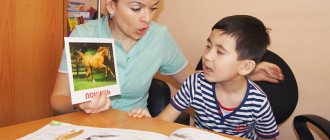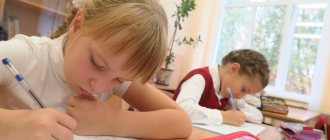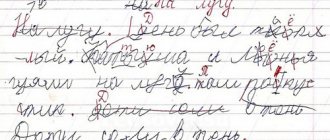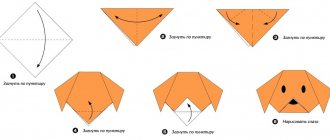– Describe yourself in three words.
– Smart, active, responsible, attentive.
Almost anyone can become the hero of a similar humorous dialogue in the modern world. But in such a situation, most often no one is in the mood for jokes. Adults, faced with their own inattention, naturally try to protect their children from the same. After all, absent-mindedness can cause various serious consequences, and in addition to the threat to safety, it affects many areas of life. Therefore, there are many techniques and exercises for developing attention and concentration in a child. However, when starting them, it is imperative to take into account the age-related characteristics of the psyche of a child, schoolchild or teenager.
What is attention?
To explain this term, we can draw an analogy where attention is a ray emitted by a light source - our consciousness. This beam can move, illuminating the area of interest to consciousness. And since the flow of light is directional, only some objects appear in the illuminated area. It is them that a person begins to notice, without attaching importance to what remains outside the illuminated area. But for attentive people this beam will be bright and concentrated. But an inattentive person in the dim and weak illumination of his beam sees everything blurry and unclear.
Scientifically speaking, attention is the direction and concentration of consciousness on any object. And this mental process is characterized by a special state of the brain, when a person brings all his cognitive systems - perception, imagination, thinking and memory - to concentration on an object that is significant to him. Concentration is one of the properties of attention, along with volume, distribution, stability and switching.
Toys to develop attention
An educational toy is a toy aimed at developing mental abilities. Often parents want to pay attention to the development of their child so much that they are ready to use the latest techniques for this and seek help from expensive educational centers.
However, the wheel does not always need to be reinvented: what is at hand will bring a lot of benefit. Board games are a great way to develop attention. Play classic chess, checkers or lotto with the whole family.
By the age of eight, it becomes interesting to play strategy games. You can feel like a spy or become a real detective. Age-appropriate puzzles are good for developing attention. You can buy books with sound design.
Puzzles will help you focus on creating the final picture.
At 8-9 years old, children actively imitate adults. Many people start creating toys on their own - wooden cars or rag dolls. Children are attracted to complex construction sets with a large set of parts.
Development of attention in children
The process of selecting information that comes into the field of attention can be involuntary and voluntary. In the first case, the consciousness unintentionally reacts to strong stimuli, movement and unfamiliar objects in the field of vision. Here we are talking about emotional perception, which a person does not control. This type of attention is also called passive or forced, because it is genetically determined and arises as a reflex. Voluntary is the result of volitional effort and is not formed immediately.
In children, attention develops in several stages:
- In the first weeks of life, the baby only adapts to the world. And only by the end of the first month does he begin to notice bright objects and can concentrate on them, and also learns to distinguish faces. It is during this period that attention appears.
- During the first year, babies are easily distracted by any noise, conversations, toys, etc. – their attention is scattered and unstable. However, closer to 10-12 months, children develop an indicative-exploratory reflex.
- From 1 year to 2 years, fixed attention predominates in children. While going about their business, they can get very carried away and not notice anything around them. Also at this stage, the first signs of voluntary attention are revealed: babies can already move independently and manipulate objects, and also understand the speech structures of adults when they are asked to look in a specified direction or at an object.
- At 2-3 years old, a stage begins when the child is able to do only one thing at a time, and if he is distracted, he switches without returning to his activity. But by the age of 4-5, this changes, and children learn to maintain focus on 2 activities at once, at least for a short time (play and simultaneously talk with adults, etc.)
- By the age of 5-6 years, voluntary attention is formed and willpower appears. The child already understands complex instructions and can follow them, and also makes the first attempts to control his attention and keep it on the object.
And then, only at the age of 6-7 years, when the basic functions of the psyche are formed and the process of improving concentration skills begins, is it considered that the child is ready for learning.
Interesting exercises
To develop the attentiveness of a child 8-10 years old, you can also use special exercises.
- Description from the memory of the main character of a fairy tale that was recently read.
- Finding all the differences in two similar pictures. For school age, bright drawings with an abundance of small details are needed. The child learns to concentrate on several things at the same time.
- Reading words backwards. It would seem like a primitive activity, but it is an excellent trainer for visual memory.
- Solving crossword puzzles. The child begins to show more perseverance. By solving entertaining tasks, the baby trains his memory. The brain is tuned to the future solution of more complex problems.
- Exercise "Find the color." The point is to correctly name the colors in which the words are written. The child focuses on the color of the code, not the word. The whole difficulty is that they do not correspond to each other. For example, the word “green” is written in red, “purple” is written in black.
- In general, lists of letters or numbers need to be found only for certain ones. You can use Schulte tables. Looking at them, the child must find all the numbers in order, while switching his attention as quickly as possible.
- Repeat exercises for adults.
- Word game. An adult names a word on a specific topic. The child repeats it and adds his own. This is how a long verbal chain is gradually built up. The players' task is not to break it off for as long as possible. For example: apple-banana-grapes-orange... (theme “Fruits”).
- Drawing by cells. The child is asked to draw a figure according to the model. It can consist of both open and closed figures. During the exercise, not only concentration of attention develops, but also fine motor skills.
Development of concentration in schoolchildren
As soon as they sit down at their desks, children of primary school age are faced with the need to concentrate for a long time on lessons and the educational process. In the classroom, students need to listen carefully to the teacher for several hours, process information in writing and orally, and maintain discipline without distractions.
At the age of 6-10 years, involuntary attention still prevails over voluntary attention. And children get tired quite quickly, so in order to conserve energy and resources, the body can switch consciousness from objective activity to other objects. So the child may not remember the material that was covered at school today, but tell in vivid colors about the nuances that instead captured his interest. The attention span during these years remains small, and the skill of distributing it between tasks remains imperfect. That is why schoolchildren, while doing class work, regularly forget to maintain their posture and sit straight at their desks. However, children already realize that absent-mindedness prevents them from achieving results, and they try to use willpower to focus on the subject of the lesson.
If at this stage you do not develop concentration and attention in younger schoolchildren, then subsequently it will be more difficult to teach them to be more focused.
On attention and logical thinking
Figures numbers and attention
In a simple version, games for the development of logical thinking are also games with pictures. Only they are a little more complicated. Such exercises are often suggested to be performed in mathematics lessons.
The child is presented with a picture consisting of several cells. As a rule, no more than 9. Each line has three different geometric shapes. There are only two of them in one line, and the child is asked to find the missing figure.
For example: in one line there is a rhombus, a triangle and a circle. The second contains a triangle, a rhombus and a circle. In the third there is only a triangle and a circle. The child must realize that the missing figure is a rhombus.
In other options, the figures are suggested to be painted. Moreover, the sequence of colors also has its own logic - either the figures have only one color intended for them, or you need to paint the figure with the missing color.
Older children can be asked to do simple exercises on adding and subtracting numbers, or try to decipher a tricky code. When certain letters are hidden behind numbers. Use a code to read a few words.
Attention, words and concepts
If the child is not very keen on mathematics, then you can simply play with words. You need to name several words united by something in common - for example: sparrow, crow, tit - birds. Apple, pear, peach are fruits. To them you need to add a word that stands out from the general group. For example, add a ball to birds, and bread to fruits. And ask the child to find the extra one.
In the same way, from several things known and obvious to the child, ask him to find the strange and unusual. For example: a kitten meows, a duckling quacks, a crow barks. What's wrong? This same exercise can be classified as developing auditory attention.
Development of concentration in adolescents
At 11-12 years old, a teenager can already consciously focus on a boring activity. But how long he is able to maintain his focus on an object depends on his true interest: the higher the interest, the easier it is to concentrate. The desire for knowledge and awareness of the need to develop also helps a teenager to be attentive. Such motivation generally improves a teenager’s attention, helps increase volume and allows for good control over its other properties.
The emotionality and unstable hormonal levels characteristic of adolescents make it difficult to manage attention; rapid fatigue and irritability that accompany maturation at the age of 13-15 years. Any external influence, poor relationships with parents or teachers, as well as weak internal motivation for learning can negatively affect a teenager’s ability to independently develop his skills, including voluntary attention.
Train now
Train right now on this page, for free and without registration.
Anagrams
Start with anagrams, they will help develop such qualities as: attention, concentration, speed of thought, speed reading. In this game you have to choose 1 option out of 4, in which only those letters that are part of the given word are mixed. Each round a new word is given. Remember that time is limited! The faster you look for the answer, the more points you will get at the end of the game.
Schulte tables
The Schulte table is one of the most effective exercises for developing the brain, attention, concentration, and accelerating visual search. This exercise is also the most popular exercise for developing speed reading. Schulte tables usually consist of randomly placed numbers or letters. The number of cells in tables also varies and most often they are 5x5 elements in size.
How to improve attention in children
An attentive child is a full-fledged and happy little person who knows how to take care of himself and loved ones, takes care of his things and the environment, is disciplined and shows responsibility and accuracy in everything. He looks at the world with enthusiasm and strives to get to know it, achieve his goals and become a full-fledged and successful member of society. This, as well as the current importance of developing attention, is important to explain to the child before starting training.
In children and adolescents, the main deficiencies that require correction of attention are: inability to concentrate on several activities at once and switch between them; short stability and weak concentration, as well as low selectivity of attention. Therefore, you need to select exercises individually, establishing the cause of inattention and determining its nature.
Training should be short, but regular and take place in a playful way. Every achievement must be celebrated with praise. To stimulate interest in training, it is advisable to alternate tasks and try to achieve one goal each training session. It is also important to limit irritants and exclude comments, hints, loud sounds and sudden movements, so as not to interfere with the child’s concentration on the exercise.
The tasks and games themselves must be chosen with the prospect of influencing mental activity and the manifestation of observation. This can be searching for errors and shortcomings, comparison, discovering patterns, giving examples, generalizing and drawing conclusions, etc. Crossword puzzles, connect-the-dots tasks, complex and detailed coloring pages, puzzles, hidden object games and mazes are also effective.







